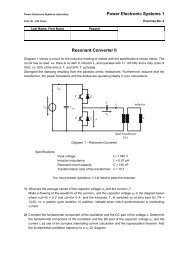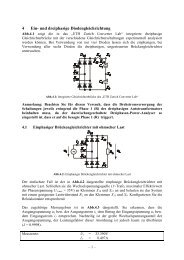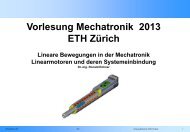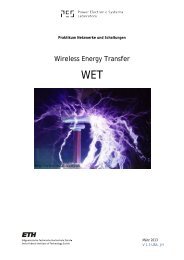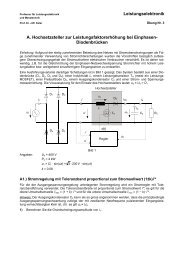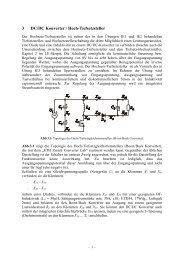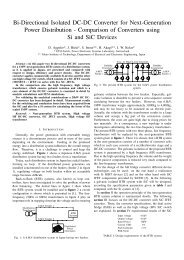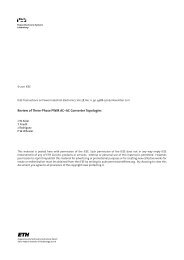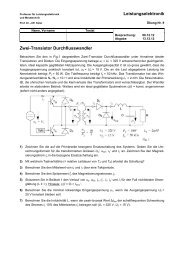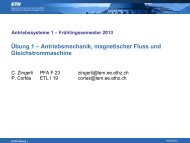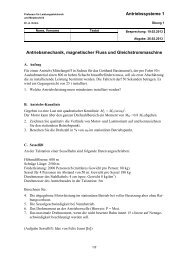U. Badstübner, J. Biela, J. W. Kolar, Power Density and Efficiency ...
U. Badstübner, J. Biela, J. W. Kolar, Power Density and Efficiency ...
U. Badstübner, J. Biela, J. W. Kolar, Power Density and Efficiency ...
You also want an ePaper? Increase the reach of your titles
YUMPU automatically turns print PDFs into web optimized ePapers that Google loves.
Transformer<br />
Heat Sink<br />
MOSFETs<br />
Gate Drives<br />
Primary <strong>and</strong> Secundary<br />
Windings<br />
Rectifier Diodes<br />
Digital Control<br />
Board<br />
Figure 11: Design of a phase shift converter with current<br />
doubler <strong>and</strong> integrated magnetics. Heat Sinks are made of<br />
aluminum.<br />
all due to the more compact design compared to the resonant<br />
converter, so that the scaling factor of 2/3 is increased.<br />
VI. CONCLUSION<br />
In this paper, an optimization procedure is used for maximizing<br />
the power density <strong>and</strong> the efficiency of a phaseshift<br />
DC-DC converter with capacitive output filter (CTC)<br />
<strong>and</strong> with current doubler (CDR) as well as a series-parallel<br />
resonant with capacitive output filter in order to identify<br />
the most suitable topology for 5 kW telecom applications.<br />
The analytical models of the optimization procedure include<br />
electrical models for the converter, models of the HF losses in<br />
the magnetic components, thermal models for the transformer<br />
<strong>and</strong> volume models for the heat sinks/resonant capacitors.<br />
There, maximal 12 kW/ltr.,196 W/in 3 (19 kW/ltr. pure component<br />
volume) are obtained for the series-parallel resonant<br />
converter (SPR). The optimal operating frequency with respect<br />
to the power density is approximately 135 kHz. For the phase<br />
shift converter 10 kW/ltr. (164 W/in 3 ) result for a capacitive<br />
output filter (CTC) <strong>and</strong> 7.8 kW/ltr. (128 W/in 3 ) for a current<br />
doubler (CDR). Again, the optimal operating frequencies are<br />
relatively low – approximately 100 kHz for the CTC <strong>and</strong><br />
200 kHz for the CDR. There, the efficiencies are 96.2 % for the<br />
SPR, 95 % for the CTC <strong>and</strong> 94.8 % for the CDR. These values<br />
slightly improve (≈ 0.8%) if the converter is optimized for<br />
efficiency, but there the power density decreases significantly.<br />
By using integrated magnetics for the CDR a volume<br />
reduction of 12 % for the magnetic components is possible.<br />
In case aluminum is used instead of copper for the heat sink<br />
<strong>and</strong> the cooling system of the transformer the system volume<br />
increases by approximately 4 %.<br />
For validating the analytical models used in the optimization<br />
a 5 kW series-parallel resonant DC-DC converter has been<br />
constructed <strong>and</strong> detailed simulations have been performed.<br />
REFERENCES<br />
[1] J. W. <strong>Kolar</strong>, U. Drofenik, J. <strong>Biela</strong>, M. L. Heldwein, H. Ertl, T. Friedli,<br />
<strong>and</strong> S. D. Round, “PWM converter power density barriers,” in Proceedings<br />
of the 4th <strong>Power</strong> Conversion Conference (PCC), apr 2007.<br />
[2] R. L. Steigerwald, R. W. D. Doncker, <strong>and</strong> M. H. Kheraluwala, “A<br />
comparison of high-power dc-dc soft-switched converter topologies,” in<br />
IEEE Transactions on Industry Applications, vol. 32, sep 1996, pp. 1139<br />
– 1145.<br />
[3] R. Petkov, D. Chapman, <strong>and</strong> D. James, “A comparative study of two<br />
dc/dc converter topologies for telecommunications,” in 18th International<br />
Telecommunications Energy Conference (INTELEC’96). IEEE,<br />
oct 1996, pp. 279–288.<br />
[4] S. Moisseev, S. Hamada, <strong>and</strong> M. Nakaoka, “Double two-switch forward<br />
transformer linked soft-switching PWM dc-dc powerconverter using<br />
IGBTs,” in Electric <strong>Power</strong> Applications, IEE Proceedings, vol. 150,<br />
jan 2003.<br />
[5] R. Chen, J. T. Strydom, <strong>and</strong> J. D. van Wyk, “Design of planar<br />
integrated passive module for zero-voltage-switched asymmetrical halfbridge<br />
PWM converter,” in IEEE transactions on industry applications,<br />
vol. 39, no. 6, nov 2003, pp. 1648–1655.<br />
[6] B. Yang, F. C. Lee, A. J. Zhang, <strong>and</strong> G. Huang, “Llc resonant<br />
converter for front end dc/dc conversion,” in Applied <strong>Power</strong> Electronics<br />
Conference <strong>and</strong> Exposition (APEC), vol. 2, mar 2002, pp. 1108–1112.<br />
[7] J. Jacobs, A. Averberg, S. Schröder, <strong>and</strong> R. D. Doncker, “Multi-phase<br />
series resonant dc-to-dc converters: Transient investigations,” in 36th<br />
Annual <strong>Power</strong> Electronics Specialists Conference, 2005, pp. 1972 –<br />
1978.<br />
[8] J. <strong>Biela</strong>, U. <strong>Badstübner</strong>, <strong>and</strong> J. W. <strong>Kolar</strong>, “Design of a 5 kw, 1 u, 10 kw/ltr<br />
resonant dc-dc converter for telecomapplications,” in 29th International<br />
Telecommunications Energy Conference (INTELEC), sep 2007.<br />
[9] A. K. S. Bhat, “A resonant converter suitable for 650 v dc bus operation,”<br />
in IEEE Transaction on <strong>Power</strong> Electronics, vol. 6, oct 1991, pp. 739–<br />
748.<br />
[10] J. Elek <strong>and</strong> D. Knurek, “Design of a 200 amp telecom rectifier family<br />
using 50 amp dc-dc converters,” in The 21st International Telecommunications<br />
Energy Conference (INTELEC), jun 1999.<br />
[11] J. A. Sabate, V. Vlatkovic, R. B. Ridley, F. C. Lee, <strong>and</strong> B. H.<br />
Cho, “Design considerations for high-voltage high-power full-bridge<br />
zero-voltage-switched PWM converter,” in Applied <strong>Power</strong> Electronics<br />
Conference <strong>and</strong> Exposition (APEC), mar 1990, pp. 275–284.<br />
[12] J. W. <strong>Kolar</strong>, J. <strong>Biela</strong>, <strong>and</strong> U. Badstuebner, “Impact of power density<br />
maximization on efficiency of dc-dc converter systems,” in The 7th<br />
International Conference on <strong>Power</strong> Electronics (ICPE’07), oct 2007.<br />
[13] T. F. Vescovi <strong>and</strong> N. C. H. Vun, “A switched-mode 200 a 48 v<br />
rectifier/battery charger for telecommunicationsapplications,” in 12th<br />
International Telecommunications Energy Conference (INTELEC ’90),<br />
1990, pp. 112–118.<br />
[14] R. L. Steigerwald, “A comparison of half-bridge resonant converter<br />
topologies,” in IEEE Transactions on <strong>Power</strong> Electronics, vol. 3, apr<br />
1988, pp. 174 – 182.<br />
[15] J. <strong>Biela</strong> <strong>and</strong> J. W. <strong>Kolar</strong>, “Analytic model inclusive transformer for<br />
resonant converters based on extendedfundamental frequency analysis<br />
for resonant converter-design <strong>and</strong> optimization,” in Transactions of the<br />
Institute of Electrical Engineers of Japan (IEEJ), ser. 5, vol. 126, 2006,<br />
pp. 568 – 577.<br />
[16] V. Vlatkovic, J. A. Sabate, R. B. Ridley, F. C. Lee, <strong>and</strong> B. H. Cho,<br />
“Small-signal analysis of the phase-shifted PWM converter,” in IEEE<br />
Transactions on <strong>Power</strong> Electronics, vol. 7, jan 1992, pp. 128–135.<br />
[17] U. Drofenik, G. Laimer, <strong>and</strong> J. W. <strong>Kolar</strong>, “Theoretical converter power<br />
density limits for forced convection cooling,” in Proceedings of the<br />
International PCIM Europe 2005 Conference, jun 2005, pp. 608–619.<br />
[18] W. G. Hurley, E. Gath, <strong>and</strong> J. D. Breslin, “Optimizing the ac resistance<br />
of multilayer transformer windings with arbitrary current waveforms,”<br />
in IEEE Transaction on <strong>Power</strong> Electronics, vol. 15, no. 2, mar 2000,<br />
pp. 369–376.<br />
[19] H. Zhou, T. X. Wu, I. Batarseh, <strong>and</strong> K. D. T. Ngo, “Comparative<br />
investigation on different topologies of integrated magnetic structures for<br />
current-doubler rectifier,” in <strong>Power</strong> Electronics Specialists Conference<br />
PESC 2007, 2007, pp. 337–342.<br />
[20] P. Xu, M. Ye, P.-L. Wong, <strong>and</strong> F. C. Lee, “Design of 48 v voltage regulator<br />
modules with a novel integrated magnetics,” in IEEE Transactions<br />
on <strong>Power</strong> Electronics, vol. 17, no. 6, nov 2002, pp. 990–998.



